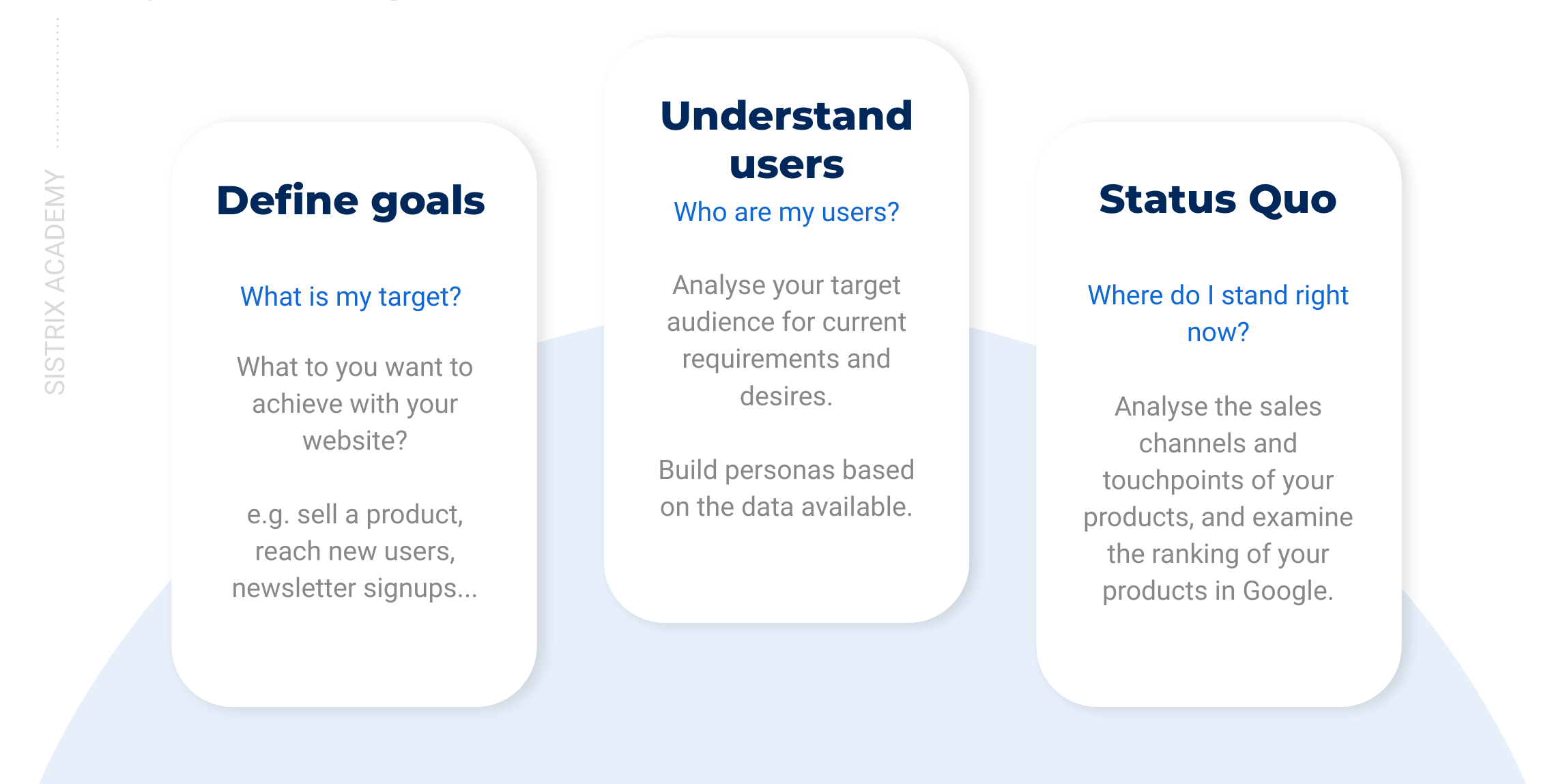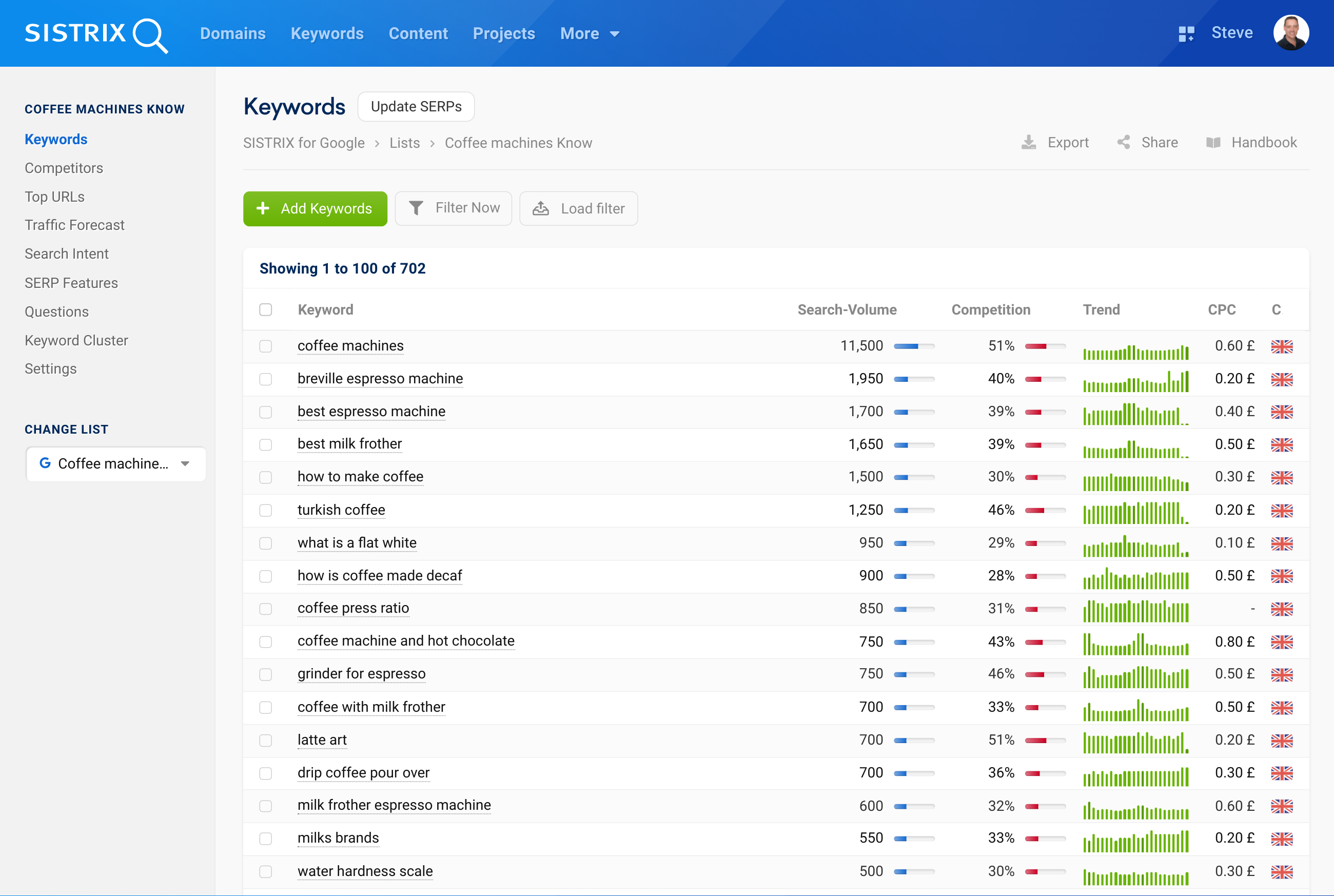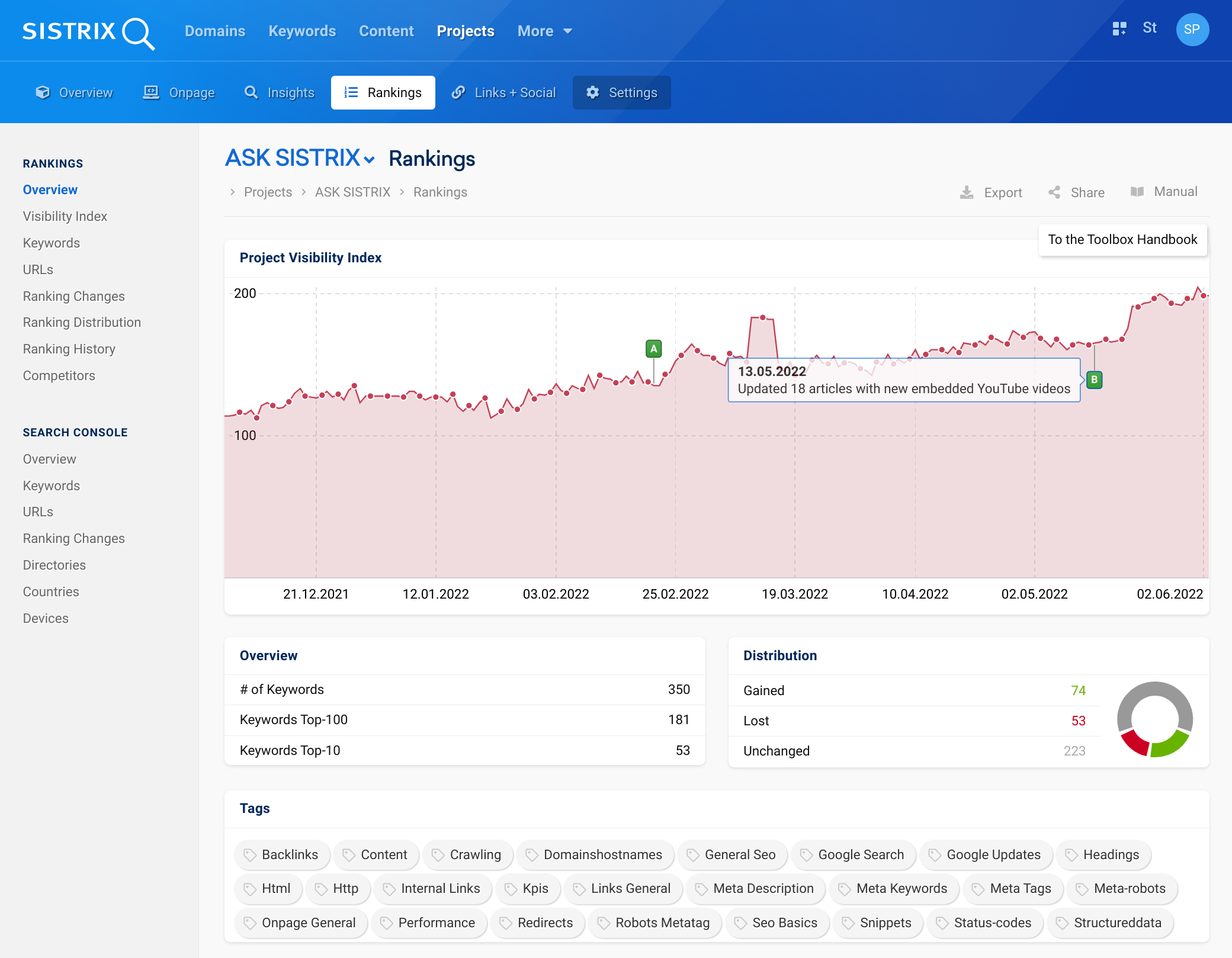A casual approach to keyword research can lead to the wrong content. Content needs to be developed from a well-researched and filtered keyword set, and combined in a way that leads to trust from Google. Here’s an a quick and efficient keyword research process that will result in relevant keywords, intent filtering and quick clustering and prioritisation for content projects.
SISTRIX toolbox features are built to help SEOs save time and get more accurate and better performing results. Our high quality keyword research datases use multiple sources of data, include up to 15 years of detailed history and are the most up-to-date in the industry.
The keyword research process below shows how our tools fit together to create a smooth and accurate workflow that saves SEOs time.
These are the steps you’ll need to take.
- Define audience and strategy
- Build a core keyword list
- Expand, organise and cluster the list
- Create briefs and content
- Publish and link
- Monitor performance
You’ll find an overview of each step below and if you want to perform further keyword research or use the relevant tools, we’ve linked to further information and handbooks.
Keyword Research – A backgrounder. Why is keyword research important?
Define content audience and content strategy
Before you start you need to define the goals. What do you want to achieve with the website. Do you want to sell a product, reach new users, distribute a study, collect email addresses?
Only when you’ve clearly defined your goals, can you measure your progress towards them because without setting them, you’ll never be able to measure success.
Understand the target customer, create buyer personas, ask questions, look at the competition and decide how you would like to use a content project to boost visibility in search.
Do you want to attract people that are ready to buy, or to provide them with helpful content on their journey? These decisions will need to be made before looking at any keywords.

Build a core keyword list
Now that you have a rough idea of where you are and what you want to achieve, you can start collecting a list of keyword ideas. This keyword research should contain the following items:
- Keywords that describe what your potential customers would be looking for. Example: “E-bike for grandma.” or “coffee machine for two people”.
- Keywords that describe your business. Example: “a range of e-bikes and personalised support.” or “a range of high quality coffee machines for the home”.
You won’t need every single keyword. Choose valuable search terms / keywords and focus on them. Keep your customer’s intent in mind. Are your target customers buying, researching a purchase, or hobbyists looking for the latest developments, for example.
The SISTRIX Keyword Discovery Tool and the Keyword List features are your starting point for gathering your initial set of keywords. After this process is complete you can expand and refine the keyword set.

Enter keyword 1 then select a group or groups you are interested in 2, select the keywords 3 and then add them to a list 4
An alternative method is to take you core keyword, or keywords, and to use the SISTRIX Keyword Environment feature which will highlight all the known keywords that rank among the top URLs in the SERPs. By doing this you are orienting you keyword set towards an existing cluster used by Google in their SERPs.
Keyword research can be done using SISTRIX tools, from the billions of keywords we have in the Keyword Discovery, or through the harvesting of keywords ranking on successful domains and URLs in your target country. All domains in SISTRIX are updated and added to our historical archive on a daily basis.

Organise, expand and cluster your keywords in SISTRIX Lists
SISTRIX lists are not just a notepad or storage area. We have included features in the SISTRIX Lists that can process, organise and filter keywords according to your target customer requirements.
If you want to select all keywords that have a strong “Know” intent, you can. You might do this if you’re building an informational content hub. If you want to find the “Do” intent keywords, you can also filter down to these. You might do this if you’re writing text for product sales landing pages.

Once you’re refined your keyword set you can view the top-performing URLs and domains. This will give you the perfect insights into what’s already working with Google and allow you to harvest ranking keywords (choose the top 10 or top 20 positions with a reasonable search volume) from relevant content areas to add to your lists.

Also included in lists: Traffic forecasting models (which can help you evaluate the value of the project), top domains – the online competitors aren’t always what you think they are.
Automated keyword clustering will use existing Google SERPs data to group keywords into SERP-targets. This allows you to write content pages with topics that work together for Google. Once you’ve clustered your keywords you’re ready to create the briefs and start the content writing process. That’s where the SISTRIX Content Assistant, powered by AI, can help optimise the process.
Always create lists that are user-intent-focused. Once you’ve clustered your keywords, look at the search history and prioritise topics with a rising search trend. Add your chosen clusters to separate lists in preparation for the next step.
Learn more about lists and list processing.
Content creation, with AI support
Authoring the right content can only be done with the right briefing and guidelines. You’ve completed a user-focused keyword research process and organised the keywords into clusters. It’s now time to consider the relevant questions and the feature boxes that are found in the SERPs, which can help the author structure the content to take advantage of video, image and other SERP features.
The SISTRIX Content Assistant AI will take your refined cluster of keywords and guide you through a tried and tested (really, over a year of testing!) content creation process. We offer template ideas and questions found in the search results to guide you through a controlled process.
We’ll take keywords in your list into consideration when prompting the AI model and allow you to set data targets, reminders, checklists, reading quality and perform plagiarism checks. We offer AI support at many levels in the editor.
If you need inspiration, or you want to give the author guidance based on existing successful content, there’s a list of successful URLs available for you to choose from, right in the tool.
Once your text creation is complete you can export in PDF, Word, HTML or plain text format. Importing of existing content is also supported.
Learn more about the content assistant.
Publish and link
Publishing is not just a one-button operation. Proof-reading, title optimisation and first-paragraph refinement are important steps to take before publishing. Ensure that you’ve included relevant and original graphics and other media if necessary.
Before publishing, ensure that the URL is correctly formed, that the content is placed in the correct directory and that internal, and external linking is optimised to connect it to the most likely customer journey.
Finally, after publishing, share on all relevant platforms and through your newsletters if relevant. Nobody is monitoring your website, waiting for the new content.
Check that the URL has been indexed by Google after a reasonable length of time, via Google Search Console.
Content project monitoring
Well done, you’ve published content. But is it working? Is it performing? Once the content is published, the hub keywords can be tagged and added to a performance monitoring tool, the SISTRIX Optimizer will keep an eye on page speed, uptime and over 150 on-page seo checks.

On-page errors are detailed and content is available for each of them, helping you to improve over time. The project Visibility Index is a distraction-free way to monitor content-project performance and track the effects of changes made, without having to worry about overall domain performance.
Further training: SISTRIX Workshop
If you would like to learn this process, in detail, with an expert, check for an up-coming workshop. The 4 hour, small group sessions are held by an SEO expert, and you’ll come out with refined SEO processes that will save time and get you better results. The workshops are customer focused, but open to our free trial users.